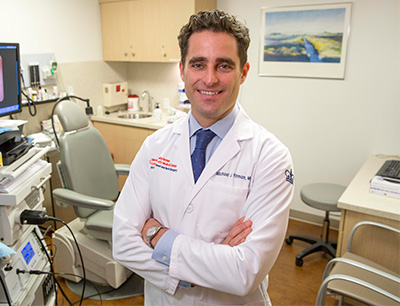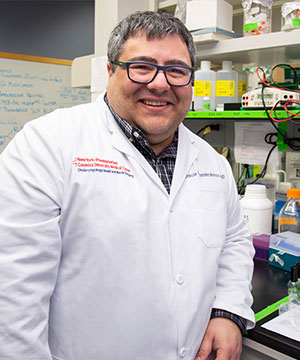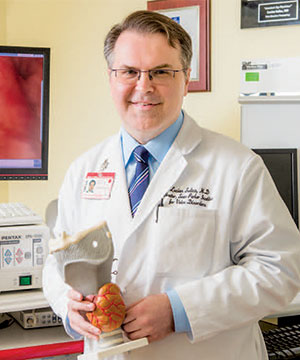Leaders in Voice Preservation & Recovery
Both NewYork-Presbyterian/Weill Cornell and NewYork-Presbyterian/Columbia are home to international experts in laryngology, providing comprehensive care for all types of voice and swallowing disorders. Laryngologists, voice scientists, speech/language pathologists, and other healthcare professionals collaborate to assess each patient and customize a treatment plan. Our investigators are also conducting research to evaluate outcomes and improve the care of patients with vocal fold hemorrhage, idiopathic vocal fold paralysis, dysphonia, and dysphagia. Special services for performing artists are available at both institutions.
Voice and Swallowing Institute at NewYork-Presbyterian/Columbia

Michael J. Pitman, MD, Chief, Division of Laryngology, and Director, Voice and Swallowing Institute, NewYork-Presbyterian/Columbia
The team at the Voice and Swallowing Institute is dedicated to helping everyone — from Broadway and opera singers to nonperformers — communicate more clearly, easily, and effectively. A number of research efforts are underway to improve sore throat, cough, laryngitis, dysphagia, vocal cord scar, dysphonia, and recurrent laryngeal nerve injury.
A new approach to throat pain. The Institute has a grant to develop an inhalation device to improve the treatment of sore throat, cough, and laryngitis. Called HAVA, the product is designed as an over-the-counter inhaled liquid mist that is inexpensive, portable, disposable, natural, tastes good, and is more effective than conventional treatments because it covers the entire upper aerodigestive tract.
In-office surgery. Our researchers have refined office-based minimally invasive laryngeal surgical procedures that do not require general anesthesia, such as laser treatment for vocal fold leukoplakia, laryngeal mucoceles, papillomatosis, and Reinke’s edema.
Safer dysphagia treatment. NewYork-Presbyterian/Columbia surgeons produced a guide and video demonstrating the safety and effective use of endoscopic cricopharyngeal myotomy, an alternative to risky transcervical surgery for patients with dysphagia.
Care for vocal fold scars. Investigators showed that temporalis fascia grafting is an effective, low-risk treatment for patients with vocal fold scar and sulcus vocalis. They are also evaluating the use of small intestinal submucosa implantation to stimulate tissue regeneration.
The Voice and Swallowing Institute provides the full spectrum of care for voice, swallowing, and breathing disorders for patients of all ages and varying vocal demands.
A patented approach to dysphonia. Our team has achieved patents for electrical stimulation as an alternative to Botox® injections for the treatment of spasmodic dysphonia. The device is a modified cochlear implant with the lead placed in the vocal fold.

Ignacio Hernandez Morato, PhD, Associate Research Scientist, Department of Otolaryngology — Head and Neck Surgery, NewYork-Presbyterian/Columbia
Innovative lab models. Scientists have developed an animal model of recurrent laryngeal nerve injury and reinnervation and identified neurotrophic factors that may be useful to treat this injury as well as vocal fold paralysis.
Selected Publications
- Serial in-office laser treatment of vocal fold leukoplakia: Disease control and voice outcomes. The Laryngoscope. 2017;127(7):1644-51.
- Office-based 532-nm pulsed KTP laser for marsupialization of laryngeal and vallecular mucoceles. The Laryngoscope. 2017;127(5):1116-18.
- Photoangiolytic laser treatment of recurrent respiratory papillomatosis: A scaled assessment. Journal of Voice. 2013;27(1):124-28.
- The efficacy and safety in-office KTP laser treatment of Reinke’s edema. The Laryngoscope. 2012;122(12):2786-92.
- Endoscopic cricopharyngeal myotomy. Operative Techniques in Otolaryngology — Head and Neck Surgery. 2011;22(2): 135-42.
- Endoscopic cricopharyngeal myotomy: History and technique. The Laryngoscope. 2009;199(1):45-53.
- Temporalis fascia transplantation for sulcus vocalis and vocal fold scar: Long-term outcomes. Annals of Otology, Rhinology & Laryngology. 2018;127(4):223-28.
- Treatment of spasmodic dysphonia with a neuromodulating electrical implant. The Laryngoscope. 2014;124(11):2537-43.
- Blockade of glial-derived neurotrophic factor in laryngeal muscles promotes appropriate reinnervation. The Laryngoscope. 2016;126(10):E337-42.
- Embryologic innervation of the rat laryngeal musculature — a model for investigation of recurrent laryngeal nerve reinnervation. The Laryngoscope. 2013;123(12):3117-26.
Sean Parker Institute for the Voice at NewYork-Presbyterian/Weill Cornell

Lucien Sulica, MD, Director, Sean Parker Institute for the Voice, NewYork-Presbyterian/Weill Cornell
The team in the Sean Parker Institute for the Voice is devoted to the accurate diagnosis and efficient treatment of voice problems, including hoarseness; limitations in volume, projection, and pitch; pitch breaks; voice fatigue; and voice spasms. We use advanced techniques, including laryngeal electromyography, to identify subtle abnormalities. Treatments include vocal cord microsurgery and injections, laryngeal Botox injections, and medialization thyroplasty (laryngoplasty). The Institute’s investigators have published extensively on outcomes of patients with vocal fold hemorrhage and paralysis, particularly in singers.
Recovery from vocal fold paralysis. Institute investigators have found that the longer a patient has vocal fold paralysis, the lower the chance of recovery. The rate of recovery is 70 percent with treatment started close to the onset of symptoms but declines among patients who delay care.
Predicting outcomes for vocal fold hemorrhage. Many performers are terrified of vocal fold hemorrhaging, a risk of professional singing which can result in crippling scarring. Weill Cornell Medicine researchers found that patients with vocal fold varices have 10 times the rate of hemorrhage, although the overall incidence is low. One in four people with vocal fold hemorrhage and half of those with varices experiences a recurrence. However, long-term follow-up showed that vocal fold hemorrhage has no significant long-term impact on vocational stability, subjective voice quality, or perceptions of vocal function. Patients who experienced more than one recurrence had greater confidence in their recovery over time and learned what they needed to do in terms of short-term care and treatment.
Award-winning speech support. A Parker Institute laryngologist won the Health Innovation Hackathon, a sprint-like event where interdisciplinary teams come together to create solutions to benefit health, by designing an EMG-based wearable device for silent communication using cell phones for patients with no larynx. The team, called MyophonX, used 3D scanning and printing to create a mask for a laryngectomy patient. By applying machine learning to the face and neck muscle signals, they were able to use the device to differentiate patient-specific silent speech. MyophonX won the Grand Prize, providing funding to support continued work on the project.
Physicians in the Center for the Performing Artist offer expertise and particular insight into the often unique needs of performing artists, from conservatory students to professionals performing at the highest levels.
Center for the Performing Artist
Performing arts medicine is a specialty of the Center for the Performing Artist at NewYork-Presbyterian/Weill Cornell, which links artists requiring health care with the specialists they need to treat head and neck, hearing, and voice disorders. The Center has service contracts with major performing arts organizations in New York City, including The Juilliard School, Metropolitan Opera, and Manhattan School of Music, as well as award-winning Broadway shows. In addition to otolaryngology care, the Center facilitates care across the entire spectrum of medical conditions, with consultants in primary care and every specialty. They also provide coordination and navigation for multidisciplinary problems. The team most frequently addresses:
- Hearing issues in composers, singers, and musicians
- Rhinitis and sinusitis in singers and wind instrument players
- Temporomandibular joint disorder, for which our team developed novel exercises
- Facial trauma or lip, mouth, and jaw issues that may impede the playing of a wind instrument
- Voice problems, treated through the Sean Parker Institute for the Voice
- Neurologic repeated-use injuries in string players and ankle and foot problems in dancers, with those performers referred to the appropriate physicians
The staff also does outreach, such as educating students at Manhattan School of Music and Juilliard about the importance of good vocal hygiene and addressing any voice problems early. Free allergy and hearing screenings are offered each year to performers.
Selected Publications
- Time course of recovery of iatrogenic vocal fold paralysis. The Laryngoscope. 2018 Oct 16. [Epub ahead of print]
- Vocal fold hemorrhage: Factors predicting recurrence. The Laryngoscope. 2014;124(1):227-32.
- Vocal fold varices and risk of hemorrhage. The Laryngoscope. 2016;126(5):1163-68.
- Long-term consequences of vocal fold hemorrhage. The Laryngoscope. 2017;127(4):900-906.
- Dysphonia in performers: Towards a definition of laryngology of the performing voice. Journal of Voice 2014;28(3):349-55.
- Vocal fold pseudocyst: A prospective study of surgical results. The Laryngoscope. 2015:125(4):913-18.
- Contemporary review: Neurogenic cough. The Laryngoscope. 2015:125(7):1675-81.
- Sulcus vocalis: A new clinical paradigm based on a re-evaluation of histopathology. The Laryngoscope. 2016: 126(6):1397-1403.
- Laryngoscopic and stroboscopic signs in the diagnosis of vocal fold paresis. The Laryngoscope. 2017:127(9):2100-05.
- A prospective cross-over trial of injection augmentation versus botulinum toxin for essential voice tremor. The Laryngoscope. 2018:128(2):437-46.



